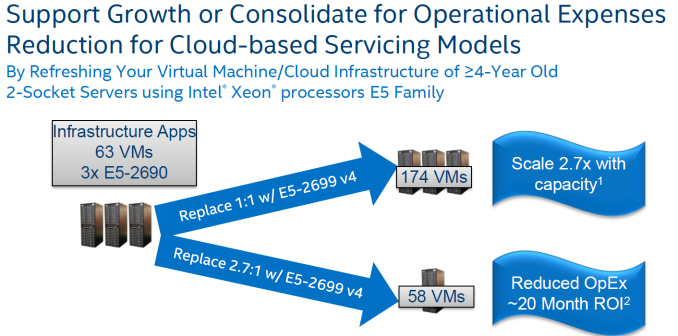The Intel Xeon E5 v4 Review: Testing Broadwell-EP With Demanding Server Workloads
by Johan De Gelas on March 31, 2016 12:30 PM EST- Posted in
- CPUs
- Intel
- Xeon
- Enterprise
- Enterprise CPUs
- Broadwell
Closing Thoughts
With the limited amount of time we had to spend with the new Broadwell-EP Xeons ahead of today's embargo, we spent most of our time on our new benchmarks. However we did a quick check on power as well. It looks like both idle power and load power when running a full floating point workload have decreased a little bit, but we need to do a more extensive check to further confirm and characterize this.
Meanwhile, considering what a wonderful offering the Xeon E5-2650L v3 was, it is a pitty that Intel did not include such a low power SKU among our samples for review. The Xeon E5-2699 v4 is a solid product, but it's not a home run. Either this is just an hiccup of our current setup (firmware?), but it seems the new Xeon E3 v4s do not reach the same turbo speeds as our Xeon E5 v3s. As a result, single threaded performance is (sometimes) slightly slower, and the new processor needs more cores to beat the previous one.
We noticed this mostly in the HPC applications, where the new Xeon is a bit of mixed bag. Still, considering that 72 to 88 threads are a bit much for lots of interesting applications (Spark, SQL databases...) there is definitely room for processors that sacrifice high core counts for higher single threaded performance (without exagerating). We have been stuck at 3.6 GHz for way too long.
With that said, there is little doubt that the Xeon E5-2699 v4 delivers in the one application that matter the most: virtualization.
Although we have not yet extensively tested on top of an hypervisor, we are pretty sure that the extra cores and the lower VMexit latencies will make this CPU perform well in virtualized environments. Intel's resource director technology and many improvements (posted interrupts) that help the hypervisor to perform better in I/O intensive tasks are very attractive features.
Although it is not much, as compared to the Haswell-EP based Xeon E5 v3s, performance has also increased by about 20% in key applications such as databases and ERP applications. And while we can complain all we want about the slightly regression in single threaded performance in some cases, the fact of the matter is that Intel has increased performance by 2 to 2.7 times in four years in those key applications, all the while holding power consumption at more or less the same. In other words, it will pay off to upgrade those Sandy Bridge-EP servers. And for many enterprises, that is what matters.











112 Comments
View All Comments
patrickjp93 - Friday, April 1, 2016 - link
Knight's Landing: 730 mm^2, also on the 14nm platformextide - Friday, April 1, 2016 - link
Is it really that big..? Wow, I knew it was big, but didn't know it was that big. Got a source on that?Kevin G - Friday, April 8, 2016 - link
I'll second a link for a source. I knew it'd be big but that big?extide - Friday, April 1, 2016 - link
I know you meant Reticle, but that was a pretty funny typo, heh.Kevin G - Friday, April 8, 2016 - link
Autocorrect has gotten the best of me yet again.extide - Friday, April 1, 2016 - link
And, I know how big GM200 and Fiji are, but I am talking about big GPU's on 14/16nm. All signs are currently pointing to <300mm^2 for the first round of 14/16nm GPU's.lorribot - Thursday, March 31, 2016 - link
Given the way Microsoft and others are now licensing by the core and in large non splitable packages (Windows 2016 Datacenter is in blocks of 16 cores, a dual socket server with 44 cores would need 48 core licences) the increasing core count has limited appeal over small numbers of faster cores when looking at virtualised environments.Those still in the physical world will still have to pay per core but may have to buy 4 std Windows licenses.
when it comes to doing your testing, it should reflect these costs and compare total bang per buck when dealing with performance.
Red Hat still licences per socket but don't be surprised if they go per core too.
JohanAnandtech - Friday, April 1, 2016 - link
Back in 2008, I had a sales person explaining the license models of Microsoft to me in our lab. From that point on, we have invested most of our time and resources in linux server software. :-Dextide - Friday, April 1, 2016 - link
Enterprise linux isn't free, either ya knowrahvin - Friday, April 1, 2016 - link
Support isn't free on the FOSS side but the software is. Redhat is never going to charge more per "cores" for support, that's ridiculous and would result in rivals stealing their support contracts. If licensing costs are that bad that you are dumping hardware you really should be looking at moving services to Linux and Visualizing the windows servers so you can limit the core count and provide more horsepower.Anyone putting Microsoft on bare hardware these days is nuts. Although the consolation is that they get to pay MS's exorbitant tax on software. Linux should be the core component of any IT services and virtualized servers where you need proprietary server software.